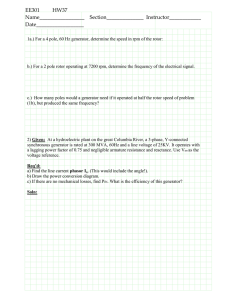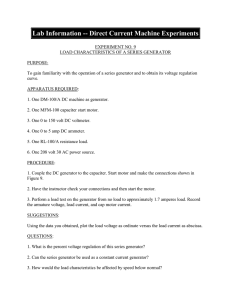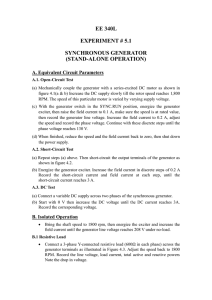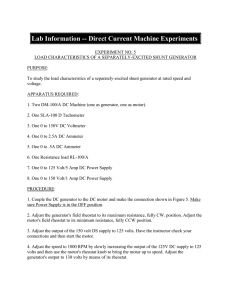ee 340l experiment # 5.1 synchronous generator
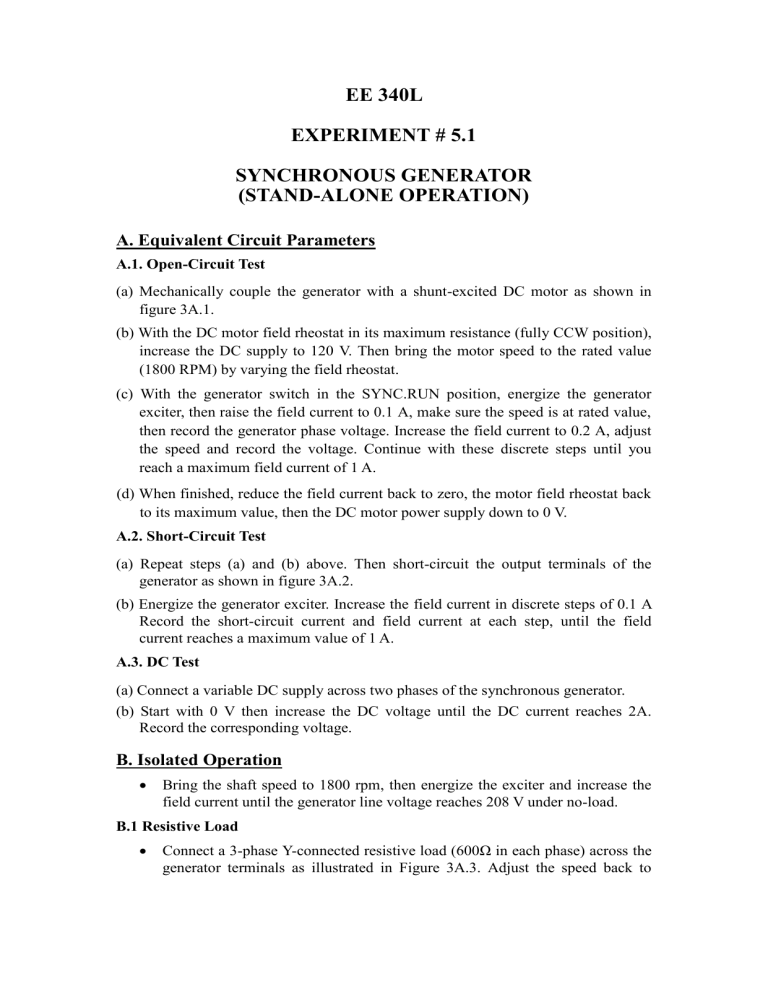
EE 340L
EXPERIMENT # 5.1
SYNCHRONOUS GENERATOR
(STAND-ALONE OPERATION)
A. Equivalent Circuit Parameters
A.1. Open-Circuit Test
(a) Mechanically couple the generator with a shunt-excited DC motor as shown in figure 3A.1.
(b) With the DC motor field rheostat in its maximum resistance (fully CCW position), increase the DC supply to 120 V. Then bring the motor speed to the rated value
(1800 RPM) by varying the field rheostat.
(c) With the generator switch in the SYNC.RUN position, energize the generator exciter, then raise the field current to 0.1 A, make sure the speed is at rated value, then record the generator phase voltage. Increase the field current to 0.2 A, adjust the speed and record the voltage. Continue with these discrete steps until you reach a maximum field current of 1 A.
(d) When finished, reduce the field current back to zero, the motor field rheostat back to its maximum value, then the DC motor power supply down to 0 V.
A.2. Short-Circuit Test
(a) Repeat steps (a) and (b) above. Then short-circuit the output terminals of the generator as shown in figure 3A.2.
(b) Energize the generator exciter. Increase the field current in discrete steps of 0.1 A
Record the short-circuit current and field current at each step, until the field current reaches a maximum value of 1 A.
A.3. DC Test
(a) Connect a variable DC supply across two phases of the synchronous generator.
(b) Start with 0 V then increase the DC voltage until the DC current reaches 2A.
Record the corresponding voltage.
B. Isolated Operation
Bring the shaft speed to 1800 rpm, then energize the exciter and increase the field current until the generator line voltage reaches 208 V under no-load.
B.1 Resistive Load
Connect a 3-phase Y-connected resistive load (600Ω in each phase) across the generator terminals as illustrated in Figure 3A.3. Adjust the speed back to
1800 RPM. Record the line voltage, load current, total active and reactive powers Note the drop in voltage.
Repeat the above step for loads of 300Ω, 200 Ω, 150 Ω, 100 Ω and 85 Ω.
Make sure the speed is maintained at 1800 rpm for each load.
B.2 Inductive Load
Repeat the above step for an inductive load, by starting with 208V under no-load. Then connect 1.6 H, 0.8 H, .533 H, .4 H, .266 H, and finally .228 H.
Make sure the speed is maintained at 1800 rpm for each load.
B.3 Capacitive Load
Repeat the above step for a capacitive load, by starting with 208V under no-load. Then connect 4 uF, 8 uF, 12uF, 16uF , 20uF, and finally 24uF . Make sure the speed is maintained at 1800 rpm for each load.
Decrease the motor speed to minimum value, disconnect the load from the generator terminals, decrease the generator field current to zero, then turn off the power supply.
QUESTIONS
A.
Equivalent Circuit:
1. Plot the generator saturation curve from the open-circuit test.
2. Plot the short-circuit current versus the field current from the short circuit test.
3. Use the results of the no-load, short-circuit and DC tests to find the internal impedance of the generator.
4. Suppose that the generator under test is short-circuited when the line voltage is
208 V. Determine an approximate value of the short-circuit current under this condition.
B. Isolated Operation:
1.
Calculate the internal voltage phasor E for each resistive load. Plot the voltage regulation curve (terminal voltage versus load current).
2.
Repeat the above for the the inductive load.
3.
Repeat the above for the capacitive load.
Fig. 3A.1
Fig. 3A.2
Fig. 3A.3

